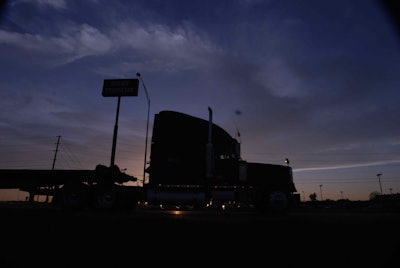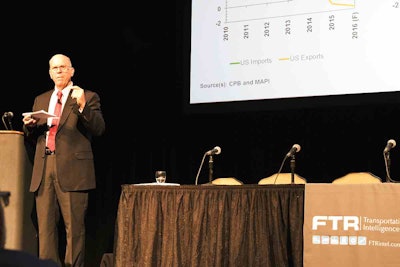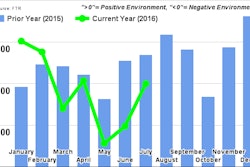 Is the economy set to stumble?
Is the economy set to stumble?Despite strong headwinds from various sources, the U.S. economy continues to grow slowly, but carriers need to have a plan in place for the coming years should the economy reverse course and dip into a recession. That was the message from two transportation economists Wednesday at the 2016 FTR Conference, ongoing this week in Indianapolis, Ind.
“Late in recovery cycles, transportation tends to perform below the level of GDP,” says FTR partner and longtime transportation economist Noel Perry. “Don’t bet the farm on growth unless you’re about to steal market share from competitors. Have a recession plan in your back pocket. Everybody hopes I’m wrong — I hope I’m wrong — but the data says it’s imperative that you’re prepared for that exposure.”
 Daniel Meckstroth speaking at the 2016 FTR Conference.
Daniel Meckstroth speaking at the 2016 FTR Conference.The U.S. economy currently is being weighed down by an overvalued U.S. dollar, a growing trade deficit (based largely on the strength of the dollar), high retail inventories and sinking commodity prices, says economist Dan Meckstroth of the Manufacturers Alliance for Productivity and Innovation.
These factors are strong enough to drag the economy into a recession, but strong consumer spending in recent years has propelled the economy to slow growth. Meckstroth cites low unemployment, higher wages and de-leveraged consumers as the key drivers of strong consumer spending.
But those aforementioned headwinds continue to undercut U.S. manufacturing, bringing with it the sluggish freight environment seen in the last 12 months.
 Noel Perry speaking at the 2016 FTR Conference.
Noel Perry speaking at the 2016 FTR Conference.Whether the U.S. economy and the freight economy can shake its restraints remains to be seen, Meckstroth says. Some indicators reveal potential growth opportunities, while others point to a potential recession.
Inventories remain high in spite of consumer spending, Meckstroth says, but the cycle should play out in the fourth quarter, which could spur a boom in U.S. manufacturing and a subsequent growth in freight.
Growth in manufacturing could rebound too in several key sectors of the economy, such as structural metals, construction machinery, engines and turbines, drilling equipment, aerospace, medical equipment and more. The housing market is also at the beginning of a growth cycle, Meckstroth says, which will continue to boost freight related to housing materials.
Commodity prices could also rebound, bringing billions of dollars worth of freight lost in recent years back to the market.
However, the U.S.’ trade deficit continues to grow, with imports increasingly outpacing U.S. exports, due to the value of the U.S. dollar and the expense of U.S.-made goods. This causes sluggish growth and weak freight, Meckstroth says.
China could also be on the verge of a recession, he says. The Chinese government is becoming over leveraged, with state-owned banks lending to inefficient state-owned institutions. The lack of returns on such lending could drive the world’s second largest economy into its first recession in 40 years, Meckstroth said.
Perry backed Meckstroth’s claims relative to a looming Chinese recession. “I think it will happen,” he says. “And it will send shock through businesses around the world.”
Perry also says the U.S. economy’s recovery from the ‘08-’09 recession is the weakest since the 1950s. Transportation’s recovery has been better than the overall economy’s. It’s grown at a rate of about 3 percent annually since the recession, compared to the U.S. economy’s 1-2 percent annualized growth.
Expectations of 3-4 percent growth, like that seen in the 1990s and early 2000s, may be unrealistic today, Meckstroth says. “The economy can’t grow like in the previous 30 years, because that growth was hyped up on credit,” he says. The consistent 4 percent growth in the late 1990s “was a bubble” based on overleveraged consumers, Meckstroth says. “The new normal is much slower growth rate.”











